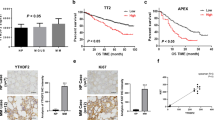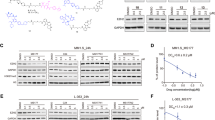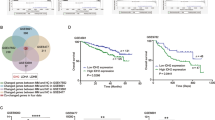Abstract
Recent studies have delineated cancer-type-specific roles of histone 3 lysine 27 (H3K27) demethylase KDM6B/JMJD3 depending on its H3K27 demethylase activity. Here we show that KDM6B is expressed in multiple myeloma (MM) cells; and that shRNA-mediated knockdown and CRISPR-mediated knockout of KDM6B abrogate MM cell growth and survival. Tumor necrosis factor-α or bone marrow stromal cell culture supernatants induce KDM6B, which is blocked by IKKβ inhibitor MLN120B, suggesting that KDM6B is regulated by NF-κB signaling in MM cells. RNA-seq and subsequent ChIP-qPCR analyses reveal that KDM6B is recruited to the loci of genes encoding components of MAPK signaling pathway including ELK1 and FOS, and upregulates expression of these genes without affecting H3K27 methylation level. Overexpression of catalytically inactive KDM6B activates expression of MAPK pathway-related genes, confirming its function independent of demethylase activity. We further demonstrate that downstream targets of KDM6B, ELK1 and FOS, confer MM cell growth. Our study therefore delineates KDM6B function that links NF-κB and MAPK signaling pathway mediating MM cell growth and survival, and validates KDM6B as a novel therapeutic target in MM.
This is a preview of subscription content, access via your institution
Access options
Subscribe to this journal
Receive 12 print issues and online access
$259.00 per year
only $21.58 per issue
Buy this article
- Purchase on Springer Link
- Instant access to full article PDF
Prices may be subject to local taxes which are calculated during checkout








Similar content being viewed by others
Accession codes
References
Hideshima T, Anderson KC . Molecular mechanisms of novel therapeutic approaches for multiple myeloma. Nat Rev Cancer 2002; 2: 927–937.
Hideshima T, Mitsiades C, Tonon G, Richardson PG, Anderson KC . Understanding multiple myeloma pathogenesis in the bone marrow to identify new therapeutic targets. Nat Rev Cancer 2007; 7: 585–598.
Manier S, Salem KZ, Park J, Landau DA, Getz G, Ghobrial IM . Genomic complexity of multiple myeloma and its clinical implications. Nat Rev Clin Oncol 2016; 14: 100–113.
Lohr JG, Stojanov P, Carter SL, Cruz-Gordillo P, Lawrence MS, Auclair D et al. Widespread genetic heterogeneity in multiple myeloma: implications for targeted therapy. Cancer Cell 2014; 25: 91–101.
Bolli N, Avet-Loiseau H, Wedge DC, Van Loo P, Alexandrov LB, Martincorena I et al. Heterogeneity of genomic evolution and mutational profiles in multiple myeloma. Nat Commun 2014; 5: 2997.
Walker BA, Boyle EM, Wardell CP, Murison A, Begum DB, Dahir NM et al. Mutational spectrum, copy number changes, and outcome: results of a sequencing study of patients with newly diagnosed myeloma. J Clin Oncol 2015; 33: 3911–3920.
De Santa F, Totaro MG, Prosperini E, Notarbartolo S, Testa G, Natoli G . The histone H3 lysine-27 demethylase Jmjd3 links inflammation to inhibition of polycomb-mediated gene silencing. Cell 2007; 130: 1083–1094.
Agger K, Cloos PA, Christensen J, Pasini D, Rose S, Rappsilber J et al. UTX and JMJD3 are histone H3K27 demethylases involved in HOX gene regulation and development. Nature 2007; 449: 731–734.
Lan F, Bayliss PE, Rinn JL, Whetstine JR, Wang JK, Chen S et al. A histone H3 lysine 27 demethylase regulates animal posterior development. Nature 2007; 449: 689–694.
Agger K, Cloos PA, Rudkjaer L, Williams K, Andersen G, Christensen J et al. The H3K27me3 demethylase JMJD3 contributes to the activation of the INK4A-ARF locus in response to oncogene- and stress-induced senescence. Genes Dev 2009; 23: 1171–1176.
Barradas M, Anderton E, Acosta JC, Li S, Banito A, Rodriguez-Niedenfuhr M et al. Histone demethylase JMJD3 contributes to epigenetic control of INK4a/ARF by oncogenic RAS. Genes Dev 2009; 23: 1177–1182.
Jepsen K, Solum D, Zhou T, McEvilly RJ, Kim HJ, Glass CK et al. SMRT-mediated repression of an H3K27 demethylase in progression from neural stem cell to neuron. Nature 2007; 450: 415–419.
Sen GL, Webster DE, Barragan DI, Chang HY, Khavari PA . Control of differentiation in a self-renewing mammalian tissue by the histone demethylase JMJD3. Genes Dev 2008; 22: 1865–1870.
Ntziachristos P, Tsirigos A, Welstead GG, Trimarchi T, Bakogianni S, Xu L et al. Contrasting roles of histone 3 lysine 27 demethylases in acute lymphoblastic leukaemia. Nature 2014; 514: 513–517.
Hashizume R, Andor N, Ihara Y, Lerner R, Gan H, Chen X et al. Pharmacologic inhibition of histone demethylation as a therapy for pediatric brainstem glioma. Nat Med 2014; 20: 1394–1396.
Park WY, Hong BJ, Lee J, Choi C, Kim MY . H3K27 demethylase JMJD3 employs the NF-kappaB and BMP signaling pathways to modulate the tumor microenvironment and promote melanoma progression and metastasis. Cancer Res 2016; 76: 161–170.
Zhang Y, Shen L, Stupack DG, Bai N, Xun J, Ren G et al. JMJD3 promotes survival of diffuse large B-cell lymphoma subtypes via distinct mechanisms. Oncotarget 2016; 7: 29387–29399.
Svotelis A, Bianco S, Madore J, Huppe G, Nordell-Markovits A, Mes-Masson AM et al. H3K27 demethylation by JMJD3 at a poised enhancer of anti-apoptotic gene BCL2 determines ERalpha ligand dependency. EMBO J 2011; 30: 3947–3961.
Wei Y, Chen R, Dimicoli S, Bueso-Ramos C, Neuberg D, Pierce S et al. Global H3K4me3 genome mapping reveals alterations of innate immunity signaling and overexpression of JMJD3 in human myelodysplastic syndrome CD34+ cells. Leukemia 2013; 27: 2177–2186.
Shah N, Asch RJ, Lysholm AS, Lebien TW . Enhancement of stress-induced apoptosis in B-lineage cells by caspase-9 inhibitor. Blood 2004; 104: 2873–2878.
Annunziata CM, Davis RE, Demchenko Y, Bellamy W, Gabrea A, Zhan F et al. Frequent engagement of the classical and alternative NF-kappaB pathways by diverse genetic abnormalities in multiple myeloma. Cancer Cell 2007; 12: 115–130.
Keats JJ, Fonseca R, Chesi M, Schop R, Baker A, Chng WJ et al. Promiscuous mutations activate the noncanonical NF-kappaB pathway in multiple myeloma. Cancer Cell 2007; 12: 131–144.
Huang, da W, Sherman BT, Lempicki RA . Systematic and integrative analysis of large gene lists using DAVID bioinformatics resources. Nat Protoc 2009; 4: 44–57.
Huang, da W, Sherman BT, Lempicki RA . Bioinformatics enrichment tools: paths toward the comprehensive functional analysis of large gene lists. Nucleic Acids Res 2009; 37: 1–13.
De Santa F, Narang V, Yap ZH, Tusi BK, Burgold T, Austenaa L et al. Jmjd3 contributes to the control of gene expression in LPS-activated macrophages. EMBO J 2009; 28: 3341–3352.
Miller SA, Mohn SE, Weinmann AS . Jmjd3 and UTX play a demethylase-independent role in chromatin remodeling to regulate T-box family member-dependent gene expression. Mol Cell 2010; 40: 594–605.
Zhao W, Li Q, Ayers S, Gu Y, Shi Z, Zhu Q et al. Jmjd3 inhibits reprogramming by upregulating expression of INK4a/Arf and targeting PHF20 for ubiquitination. Cell 2013; 152: 1037–1050.
Shaffer AL, Emre NC, Lamy L, Ngo VN, Wright G, Xiao W et al. IRF4 addiction in multiple myeloma. Nature 2008; 454: 226–231.
Ohguchi H, Hideshima T, Bhasin MK, Gorgun GT, Santo L, Cea M et al. The KDM3A-KLF2-IRF4 axis maintains myeloma cell survival. Nat Commun 2016; 7: 10258.
Deshaies RJ . Protein degradation: Prime time for PROTACs. Nature Chem Biol 2015; 11: 634–635.
Lu J, Qian Y, Altieri M, Dong H, Wang J, Raina K et al. Hijacking the E3 Ubiquitin Ligase Cereblon to Efficiently Target BRD4. Chem Biol 2015; 22: 755–763.
Winter GE, Buckley DL, Paulk J, Roberts JM, Souza A, Dhe-Paganon S et al. DRUG DEVELOPMENT. Phthalimide conjugation as a strategy for in vivo target protein degradation. Science 2015; 348: 1376–1381.
Zengerle M, Chan KH, Ciulli A . Selective small molecule induced degradation of the BET bromodomain protein BRD4. ACS Chem Biol 2015; 10: 1770–1777.
Bondeson DP, Mares A, Smith IE, Ko E, Campos S, Miah AH et al. Catalytic in vivo protein knockdown by small-molecule PROTACs. Nat Chem Biol 2015; 11: 611–617.
Acknowledgements
We thank Dr John Quackenbush and members of the Center for Cancer Computational Biology, Dana-Farber Cancer Institute for assistance with RNA-seq analysis. This research was supported by NIH grants SPORE P50-CA100707 (KCA), P01-CA078378 (KCA), R01-CA050947 (KCA) and R01-CA178264 (T Hideshima and KCA). KCA is an American Cancer Society Clinical Research Professor.
Author contributions
HO designed and performed experiments, analyzed the data and wrote the manuscript; T Harada, MS and SK analyzed the data; Y-TT and PGR provided clinical samples. T Hideshima and KCA analyzed the data and edited the manuscript.
Author information
Authors and Affiliations
Corresponding author
Ethics declarations
Competing interests
The authors declare no conflict of interest.
Additional information
Supplementary Information accompanies this paper on the Leukemia website
Rights and permissions
About this article
Cite this article
Ohguchi, H., Harada, T., Sagawa, M. et al. KDM6B modulates MAPK pathway mediating multiple myeloma cell growth and survival. Leukemia 31, 2661–2669 (2017). https://doi.org/10.1038/leu.2017.141
Received:
Revised:
Accepted:
Published:
Issue Date:
DOI: https://doi.org/10.1038/leu.2017.141
This article is cited by
-
KDM6B protects T-ALL cells from NOTCH1-induced oncogenic stress
Leukemia (2023)
-
Targeting epigenetic regulators to overcome drug resistance in cancers
Signal Transduction and Targeted Therapy (2023)
-
The H3K27 demethylase controls the lateral line embryogenesis of zebrafish
Cell Biology and Toxicology (2023)
-
KDM6 demethylases integrate DNA repair gene regulation and loss of KDM6A sensitizes human acute myeloid leukemia to PARP and BCL2 inhibition
Leukemia (2023)
-
Emerging roles of JMJD3 in cancer
Clinical and Translational Oncology (2022)



